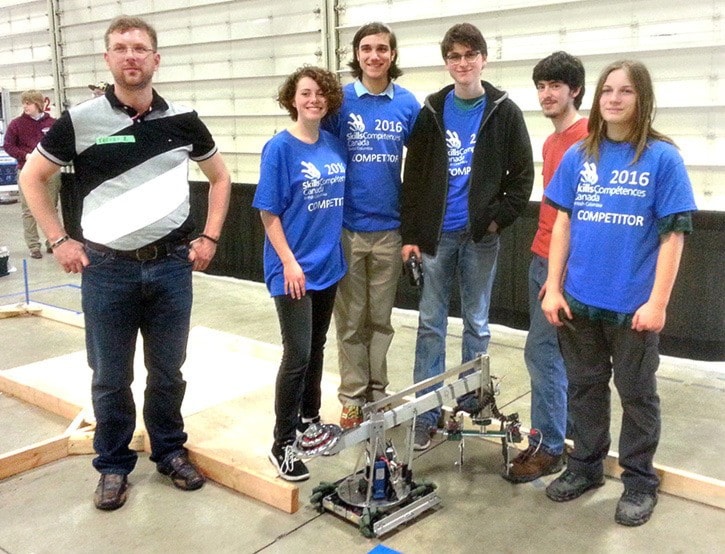Some say that nothing is achieved without painful trial and error, and that there is no such thing as luck – just hard work.
It’s true for Edward Milne Community School’s robotics team that took home silver at the Skills Canada provincial competition in Abbotsford following a close battle with some of the toughest robotics teams in the province and the U.S.
With a score of 11, EMCS lost to Mt. Baker, Wash. by one point, but the Sooke crew took it in stride, considering it built a machine from scratch, all in a matter of months.
It was also the first time an EMCS robotics team designed and fabricated its own chassis, compared to its competitors which had prebuilt chassis.
“We had the motors, the brain, the rest of it was their creativity,” said Trevor Royle, a shop teacher at EMCS and the robotics team coordinator.
The competition’s challenge was assembling a boat out of multiple wooden parts using only a robot.
The parts were spread out across an arena of sorts, which included a ramp and a maze. This tested a robot’s dexterity and mobility, as well as a team’s ability to coordinate.
Communication was more important than most of the other teams realized, said Yann Joslin, an EMCS student.
“It’s a deciding factor as a judge, and it’s really hard to hear your teammates over the crowd, so using walkie-talkies makes it easier to communicate back and forth,” he said, adding that this gave the EMCS team an edge over others who used sign language.
Joslin, along with all other pilots and co-pilots, were restricted to their box, relying solely on their “spotter” (in EMCS’ case, Sonny VanNetten) to navigate in areas of the map where visibility was either limited or restricted.
“If a wall edge blocks sight of your robot, you’re completely relying on your spotter, such as where you need to place yourself, how far you need to move your arm, or where to move,” said Triston Line, the team’s software engineer and mechanic.
This had to work in tandem with the robot’s design and functionality, which featured the ability to crab sideways, turn 360 degrees and a mechanical arm with the dexterity of a human arm.
It also helped that the chassis was customized, allowing for quick and easy repairs instead of looking to find replacement parts.
“In the qualifying round, we were definitely the competition. Having our own chassis really gave us an edge, while everyone else was relying on nuts and bolts, we were relying on welding and real manufacturing,” Line said.
It all takes more time to figure out than people realize, explained Rowan Hensley, a former EMCS student who returned as the robotics team’s mentor and technical advisor.
“That was two months of driving the robot and everything went wrong for it to go right,” he said.
“You have time to figure out what’s going to fall apart, you have time for the drivers to get acquainted with the controls, continuously trying to improve the time.”
Line pointed out his colleague’s technical support and knowledge helped the team push through its challenges, even during the competition.
“[Rowan] guided us through everything we did, he knew the ins and outs of the competition. We couldn’t have been where we were without him.”
Given the milestones it set this year, the EMCS robotics team will be back at it in 2017, Royle said.
Carpentry student brings home gold
The robotics team wasn’t the only one taking home a medal, either.
Fellow EMCS student Jake Schuttinga also won a gold medal in carpentry.
Schuttinga will now compete nationally in Moncton, N.B. in June.
